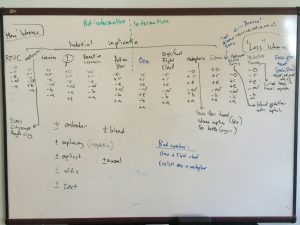New paper: Being explicit about the implicit
My cascade of recent new papers continues with my latest paper, “Being explicit about the implicit: inference generating techniques in visual narrative“, which has recently been published open access in Language and Cognition. This is a paper that was gestating for quite awhile, and it’s fun to finally see it published.
This paper is about how inference is generated in visual narratives like comics—i.e., how you get meaning when it is not provided overtly. This has been a primary focus of studies of how comics communicate at least since McCloud’s notion of “closure” in Understanding Comics, and many other scholars have posited how we “fill the gaps” for knowing what we don’t see.
However, much of this work has posited vague principles (closure, arthrology, etc.) for saying that people generate inference, but without discussing the specific cues and techniques that are used to motivate that inference in the first place. As I hope I demonstrate in this paper, inference is not a happenstance thing, and it also doesn’t occur “in the gaps between panels,” as most in comics studies seem to argue.
Rather, specific techniques motivate readers to create inference. These techniques are patterned ways of showing, or not showing, information that in turn signals to readers that they need to make an inference. The figure below provides a handy-dandy summary of some of these techniques mentioned in the paper (though it isn’t a figure in the paper). A high-res version for printing is available here if you want to use it for personal use.
The overarching argument thus is that it’s not enough to posit broad generalities for how visual narratives like comics are comprehended, but rather research should explore the specific methods and techniques that motivate that comprehension.
Not only does this paper list off these various techniques, but I also provide an analytical framework for characterizing their underlying features. This analysis actually goes back to about 5 years ago when my former students Kaitlin Pederson and Ryan Taylor met with me in my office at UCSD to brainstorm about inference, resulting in this scrawling whiteboard which laid the foundation for the table at the end of the article:
You can find the full article online here, or a pdf file here and via my downloadable papers page.
Abstract
Inference has long been acknowledged as a key aspect of comprehending narratives of all kinds, be they verbal discourse or visual narratives like comics and films. While both theoretical and empirical evidence points towards such inference generation in sequential images, most of these approaches remain at a fairly broad level. Few approaches have detailed the specific cues and constructions used to signal such inferences in the first place. This paper thereby outlines several specific entrenched constructions that motivate a reader to generate inference. These techniques include connections motivated by the morphology of visual affixes like speech balloons and thought bubbles, the omission of certain narrative categories, and the substitution of narrative categories for certain classes of panels. These mechanisms all invoke specific combinatorial structures (morphology, narrative) that mismatch with the elicited semantics, and can be generalized by a set of shared descriptive features. By detailing specific constructions, this paper aims to push the study of inference in visual narratives to be explicit about when and why meaning is ‘filled in’ by a reader, while drawing connections to inference generation in other modalities.
Cohn, Neil. 2019. Being explicit about the implicit: inference generating techniques in visual narrative. Language and cognition.


Comments